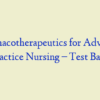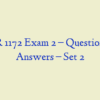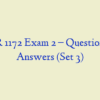Description
NU 217 Exam 3 Study Guide
- A normal age-related change in the integument?
- Teaching intervention to include after bathing an elderly client:
- In discussing healthy skin with a group of elderly you should include:
- What intervention should the nurse implement in order to promote and protect the residents’ skin?
- Health Promotion for Older Adults: Programs or interventions that focus on behavior changes directed toward:
- What is adverse drug effect?
- If you are taking iron, the following foods should be avoided, or only taken in very small amounts, for at least 1 hour before or 2 hours after you take iron:
- Iron is absorbed the best on an empty stomach. Yet, iron supplements can cause stomach cramps, nausea, and diarrhea in some people. You may need to take iron with a small amount of food to avoid this problem. Taking a vitamin C supplement or drinking orange juice with your iron pill. This can help the iron absorb into your body. You can take with a glass of water. When iron is combined with certain foods it may lose much of its value
- Assessing an elderly client with deficit in ADLs functioning determines the level of assistance need.
- Assessment of health and functioning— essential, complex component of Health and functioning affect the ability to drive a motor vehicle:
- You are conducting a medication assessment of an older adult. What statements by the older adult indicates a need for further education?
- To accurately captures the complexity involved in assessing the older adult the nurse should know that: Signs and symptoms of illness are often obscure and less predictable among older adults
- What dietary measures should the nurse recommend in preventing osteoarthritis in?
- A functional consequences related to mobility and safety would be?
- As part of a functional assessment, a nurse is assessing an older adult’s ADLs and instrumental activities of daily living (IADLs). What piece of assessment data would most likely be considered an IADL rather than an ADL?
- You are assessing an older adult client what finding should alert the nurse to an increased risk of falls?
- What statements indicates that teaching about falls is effective?
- Which measures should the nurses on the unit prioritize in order to prevent the formation of pressure ulcers?
- You are monitoring older adults for pressure ulcers. Which of the following older adult is at highest risk for a pressure ulcer?
- You monitor a group of older adults in the long-term care facility’s kitchen. What action would cause you to intervene?
- Similarities and differences between gerontology and geriatrics. The question best conveys the focus of gerontology?
- You observes that a client on the unit frequently stumbles when ambulating with a walker. What action by the nurse is best?
- What environmental factors should the nurse address with the resident to avoid falls?
- An 82-year-old client is getting advice from a family member on how to drive safely. What piece of advice should the older adult follow?
- A postmenopausal woman asks the nurse what she can do to reduce her risk for osteoporosis. What suggestion should the nurse make?
- Prescription medications can interact with any other biologically active substances. Your patient tells you that it is safe to take as many vitamins and minerals as they want because they have USP labels on the containers. How would you respond?
- Having completed a medication assessment and physical assessment of a new client, a home care nurse is now creating nursing diagnoses and choosing interventions appropriate to these diagnoses. What factor should the nurse prioritize in this process?
- The nurse assesses the fluid volume status of a 72-year-old client who takes Lasix (furosemide) and Pacerone (amiodarone). Which of the following is the most reliable method for assessing this client’s skin turgor?
- Which of the following interventions most closely aligns with the practices of health promotion?
- What types of programs help older adults prevent having heart disease?
- Use of calendars and notes help older adults with?
- What is some age-related changes to the integumentary system with aging? (select all that apply)
- What are some medication issues for the elderly? (select all that apply)
- Impaired mobility can be caused what problems? (select all that apply)
- You are teaching a class about aging. Which client statement suggests the needs further teaching?
- Medication misuse affect up to 17% of Americans ages 65 and older: What statement by the client indicates that he or she do not misuse medication?
- A nurse in a long-term care facility assists several residents with bathing each day. What intervention should the nurse implement in order to promote and protect the residents’ skin?
- A nurse is participating in a health fair that is being sponsored by a local seniors’ center, discussing healthy skin and aging. Which of the following teaching points should the nurse emphasize?
- A nurse is caring for a client, diagnosed with osteoarthritis, who refuses to perform independent care. What is the most important nursing intervention for this client?
- Mr. Roth is an 81-year-old hospital patient whose health problems include Alzheimer’s disease and failure to thrive. The nurses who provide care for Mr. Roth have emphasized the importance of ringing his call light for assistance when he has the urge to void, but to this point he has failed to do so. During the night, the nurse discovered Mr. Roth attempting to scale his bed rails to go to the bathroom. What nursing diagnosis is most appropriate for Mr. Roth?
- A nurse reviews the medication list of an older adult upon transfer from the hospital to an extended care facility. Which of the following methods is most likely to reduce the occurrence of adverse effects?
- A nurse notes that an older adult is unable to process complex thoughts and has difficulty forming sentences. Which of the following actions by the nurse is priority?
- An older adult is being assessed by a home health nurse. During the interview, the nurse finds out that the patient takes Garlic as an herbal supplement in addition to her other medication for high blood pressure and DVT (deep vein thrombosis). Which statement by the patient indicates that she needs further education about taking this herbal product?
- Which pharmacokinetic parameter is affected most by decreased intestinal motility related to the aging process?
- Age related changes that affect medication effectiveness except:
- What information should you assess to ensure medication safety? (Select all that apply)
- A nurse at a long-term care facility completes a minimum data set on each client. Which categories are included in this assessment/plan of care? (Select all that apply.)
- A nurse is responsible for assessing an older adult in an acute care setting. Which statement most accurately captures the complexity involved in assessing the older adult?
- A nurse wants to avoid overstimulating her 88-year-old client who has limited mobility, yet still provide enough engagement to make his activities enjoyable. Which action of the nurse if most appropriate?
- A nurse was recently assisting an older adult resident with a biweekly bath. While the nurse was helping the resident transfer out of the bathtub, the resident grabbed on to the nurse forcefully, became rigid, and exclaimed, “Help me quick.” For which reaction should the nurse prepare to intervene?
- A nursing home has been the site of numerous falls by residents in recent months. Which environmental factors should the nurse manager change?
- An older adult client is scheduled to undergo hip replacement surgery after a fracture resultant from a fall. Which age-related change may have contributed to the client’s susceptibility to bone fracture?
- An older adult client with osteoarthritis walked 2 miles last week. The client says since that time, “I haven’t been doing very much; I’m afraid it will hurt like last time.” Which action by the nurse is most appropriate?
- The home nurse assesses a frail older adult for fall risk using the Timed Up and Go (TUG) test. Which score places this client at high risk for falls in the client’s home?
- The nurse cares for a client with advanced Alzheimer’s disease who is not mobile. The nurse has assessed the client as high risk for falls. Which teaching should be included in the fall-prevention program?
- The older adult client who went rock climbing last week and snowboarding this week is at risk for broken bones. Which functional consequence of aging most strongly increases this risk?
- Which older adult is most at risk to develop osteoporosis?
- A nurse assesses older adults at risk for pressure ulcers. Which assessment tools should the nurse use to identify those who might benefit from interventions?
- A nurse at the dermatology office triages calls. Which client is the priority to follow up?
- A nurse evaluates the healing of a full-thickness skin tear on an older adult resident who lives in a long-term care facility. Which finding would support the continuation of the current treatment plan?
- Upon admission to the facility, the nurse assesses the medication bottles of an older adult prescribed over 5 medications. Which of the following findings should the nurse be concerned with for this older adult?
- A nurse is conducting a medication assessment of an older adult client who will be receiving home care. Which questions should the nurse include in this assessment?
- Which risk factor may have a negative effect on bioactive substances and the older adult?
- An older adult admitted to a long-term care facility is diagnosed with type 2 diabetes and coronary artery disease. The client takes glipizide and isosorbide mononitrate. The medical history states that the client drank 4 ounces of whiskey per day for many years. Which action should be a priority for the admitting nurse?
- A group of nurses is involved in the planning and implementation of a health promotion campaign that is aimed at older adults. Which of the following questions is the best guide to such a campaign?
- A nurse is assessing a newly admitted 84-year old’s activities of daily living. Which of the following activities would the nurse would be assessing during the admission assessment.
- Mr. Dey is a 69-year-old man who has been a cigarette smoker since his late teens. In recent weeks, he has asked the nurse who helps manage his diabetes numerous questions about the potential benefits of quitting smoking, a subject that he has normally avoided in past interactions. The nurse has now explicitly asked Mr. Dey if he would like to quit smoking, to which he has replied that he will “give it some serious thought.” Mr. Dey is demonstrating what stage of the
- Mr. W has recently been diagnosed with rheumatoid arthritis, a chronic condition that significant impacts his daily routines and his quality of life. Which one of following statements best reflects the nurse’s recognition of the importance of healing rather than curing Mr. W’s condition?
- The nurse is working with a 79-year-old female patient with a diagnosis of osteoporosis. Which of the following interactions best exemplifies the nurse’s understanding of the relationship between age-related changes and risk factors?
- A gerontological nurse who works in a public health setting has limited funding for initiatives. Which initiative is most likely to result in significant benefits for the older adults who participate?
- A graduate nurse expresses an interest in studying healthy aging in the future. Toward which field should the experienced nurse steer the graduate nurse?
- A nurse is teaching nursing students about the importance of health promotion among older adults. Which statement by a student indicates a need for further teaching?
- Which circumstance would be most likely to render a screening program successful?
- A nurse is participating in a health fair that is being sponsored by a local seniors’ center, discussing healthy skin and aging. Which of the following teaching points should the nurse emphasize?
- As part of a functional assessment, a nurse is assessing an older adult’s ADLs and instrumental activities of daily living (IADLs). What piece of assessment data would most likely be considered an IADL rather than an ADL?






